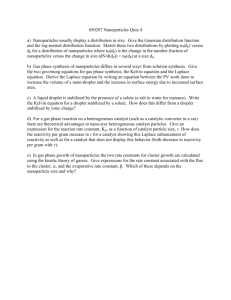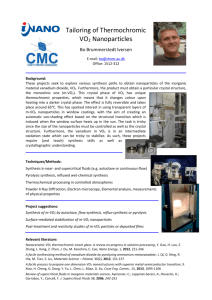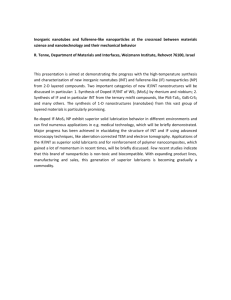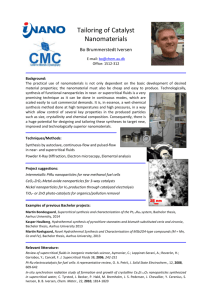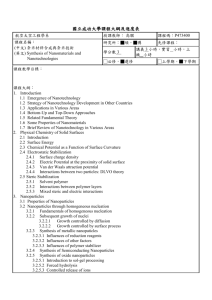Microsoft Word
advertisement
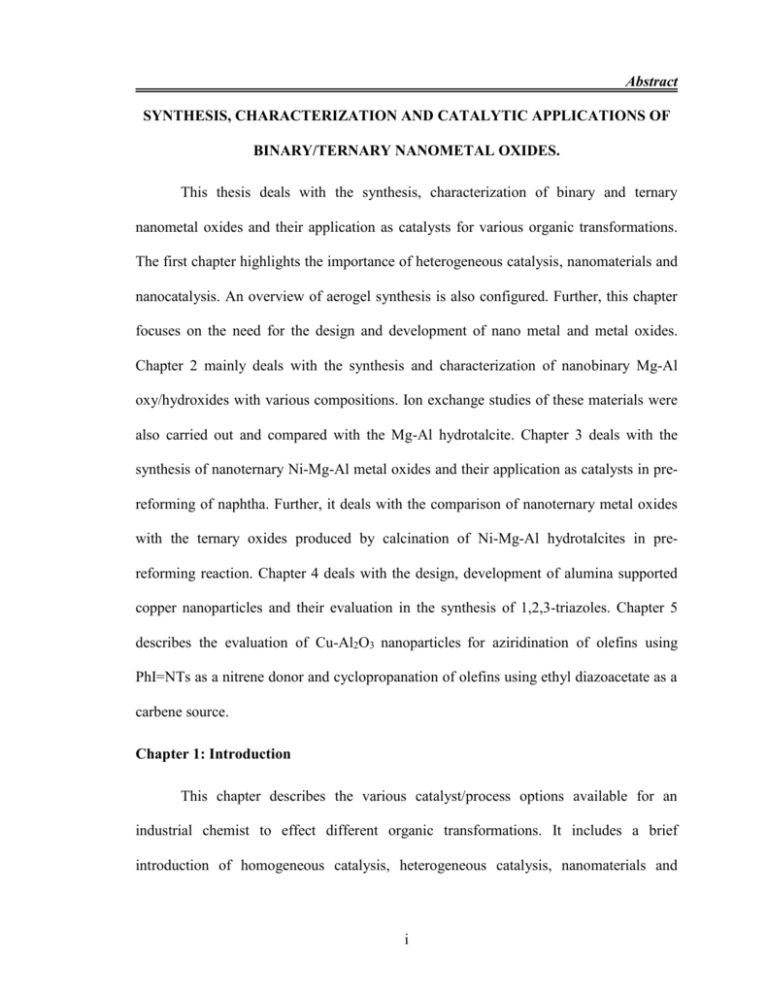
Abstract SYNTHESIS, CHARACTERIZATION AND CATALYTIC APPLICATIONS OF BINARY/TERNARY NANOMETAL OXIDES. This thesis deals with the synthesis, characterization of binary and ternary nanometal oxides and their application as catalysts for various organic transformations. The first chapter highlights the importance of heterogeneous catalysis, nanomaterials and nanocatalysis. An overview of aerogel synthesis is also configured. Further, this chapter focuses on the need for the design and development of nano metal and metal oxides. Chapter 2 mainly deals with the synthesis and characterization of nanobinary Mg-Al oxy/hydroxides with various compositions. Ion exchange studies of these materials were also carried out and compared with the Mg-Al hydrotalcite. Chapter 3 deals with the synthesis of nanoternary Ni-Mg-Al metal oxides and their application as catalysts in prereforming of naphtha. Further, it deals with the comparison of nanoternary metal oxides with the ternary oxides produced by calcination of Ni-Mg-Al hydrotalcites in prereforming reaction. Chapter 4 deals with the design, development of alumina supported copper nanoparticles and their evaluation in the synthesis of 1,2,3-triazoles. Chapter 5 describes the evaluation of Cu-Al2O3 nanoparticles for aziridination of olefins using PhI=NTs as a nitrene donor and cyclopropanation of olefins using ethyl diazoacetate as a carbene source. Chapter 1: Introduction This chapter describes the various catalyst/process options available for an industrial chemist to effect different organic transformations. It includes a brief introduction of homogeneous catalysis, heterogeneous catalysis, nanomaterials and i Abstract nanocatalysis. The importance and the need for the design and development of environmentally cleaner catalytic methodologies is also highlighted. This chapter also describes the importance of nanomaterials as catalysts for organic synthesis. Chapter 2: Synthesis, Characterization and Ion Exchange Studies of Nanobinary Mg-Al Oxy/Hydroxides This chapter is divided into two sections Section 1: Synthesis and Characterization of Nanobinary Mg-Al Oxy/Hydroxides This section deals with the synthesis and characterization of the nanobinary Mg-Aloxy/hydroxides. Synthesis of nanobinary Mg-Al oxy/hydroxides by modified aerogel method: The nanobinary Mg-Al-oxides were synthesized in different Mg-Al ratios by an aerogel method. The key features of this method are homogenization of metal organic precursors in methanol-toluene mixtures, controlled hydrolysis, gelation, hydrothermal treatment and finally supercritical drying of solvent. The obtained materials were further dried at 120 ºC, displayed high surface area, >500 m2 g-1 and smaller particle size. The materials are well characterized by using various instrumental techniques such as powder XRD, TEM, TGA, DTA, 27Al MAS NMR and FT-IR spectroscopy. The thermal behavior, FTIR and 27Al MAS NMR of the aerogel materials are comparable with the layered double hydroxides prepared by the conventional method. ii Abstract Metal precursor solution Hydrolysis Aging Solvent removal Drying T = 120 C Product SA: 400-700 m2g-1 Flow chart for the synthesis of nanomaterials by aerogel method Section 2: Intercalation and Ion Exchange Studies of Nanobinary Mg-Al Oxy/Hydroxides This section deals with the intercalation and ion exchange studies of the nanobinary MgAl oxy/hydroxides. The ion exchange properties were studied for the aerogel material and compared with that of conventionally prepared material (Scheme 1). The intercalation of monovalent and bivalent anions was studied. The aerogel material is initially intercalated with chloride anion is exchanged with the divalent HPO4-2 anion. The obtained catalysts iii Abstract were fully characterized by using various instrumental techniques such as powder XRD, TEM, SEM, TGA, DTA, 27 Al MAS NMR. The XRD of the ion-exchanged materials resemble the typical hydrotalcite pattern with less crystallite size. +3 O Al _ OH O O _ OH O Al H2O +2 O O +2 +2 H 2O O Mg O O Mg _ OH +2 _ OH _ OH O Mg O +3 Al O O _ OH Mg O +2 Mg Mg _ OH +3 O +2 +3 Al O O = OH Scheme 1: Plausible structure of OH- intercalated Mg-Al system. Chapter 3: Design and Development of Nanoternary Ni-Mg/Al Metal Oxides for Pre-Reforming of Naphtha In this chapter, preparation, characterization and application of nanoternary NiMg/Al oxides in the pre-reforming of naphtha has been presented. Hydrogen has an extensive use in a variety of industrial processes going from hydrocracking-hydrotreating in oil refining, to fine chemicals production and also as raw material in synthesis of organic compounds. Apart from later, the major users of hydrogen are currently the refineries consuming ca. 85% of the total amount produced worldwide, most of which (ca. 65% in US refineries) is available from the catalytic reforming of naphtha. Pre-reforming is an important process that converts higher hydrocarbons (naphtha) with steam catalytically to a so-called rich gas with a high content of methane. Pre-reforming has become an integrated process step in modern syngas production and widely used in the chemical industry: in plants for synthesis of iv Abstract methanol and ammonia and in plants producing CO and CO/H2 mixtures for the synthesis of various bulk chemicals. Pre-reforming process Pre-reforming is used to convert hydrocarbon feedstocks at a low temperature range, typically from 400 to 550 oC. During reforming naphtha, mainly straight chain alkanes, with 6-10 carbon atoms, are re-formed into molecules with the same or less number of carbon atoms (methane and carbon oxides) with intermediate products by steam reforming reactions (1-3): CnHm + nH2O nCO + (n + ½ m) H2 (1) (-ΔH0298 = -1108 kJ/mol, n = 7) CO + 3H2 CH4 + H2O (-ΔH0298 = 206.2 kJ/mol) (2) CO + H2O CO2 + H2 (-ΔH0298 = 41.2 kJ/mol) (3) Steam reforming reaction (1) can be considered irreversible for all higher hydrocarbons (n > 1) and all higher hydrocarbons are completely converted provided sufficient catalyst activity exists. Reaction (1) is followed by the establishment of the equilibria of the exothermic methanation reaction (2) and water gas shift reaction (3), methane being the favored product at low temperatures and CO and CO2 the preferred reaction products at high temperatures. The ternary Ni-Mg/Al metal oxides were synthesized and well characterized by using various instrumental techniques such as powder XRD, TEM, FT-IR, TPR, Chemisorption and AAS to draw a correlation between the structure and activity of the nanoternary systems. The ternary systems were employed in pre-reforming of naphtha at low temperatures i.e at 400-450 ºC and at the pressure of 5 atmospheres (Scheme 2). v Abstract CH3CH2CH2CH2CH2CH3 + (C6H14) 3H2O Ni-Catalyst 4CH4 + 2H2+ CO2 + CO 400-450 C, 5 atm o Scheme 2: Pre-reforming of Naphtha. Synthesis of the catalyst by coprecipitation method: The Ni-Mg-Al-LDH catalysts were synthesized by a coprecipitation method. Metal salt precursors Addition Alkali Solution rt, pH 10 LDH Formation LDH Aging T = 70 C, Time=18 hours Washing & Filtration Drying T = 110 C Product SA: 60-80 m2g-1 Flow chart for the synthesis of the LDH by conventional coprecipitation method vi Abstract Synthesis and Characterization of nanoternary Ni--Mg/Al oxy/hydroxides. Dispersed nanoternary Ni-Mg/Al oxy/hydroxides were prepared by employing modified aerogel method. The key features of this method are homogenization of metal organic precursors in methanol-toluene mixture, controlled hydrolysis, gelation, hydrothermal treatment, and finally supercritical drying of solvent. Magnesium turnings, nickel(II) acetylacetonate, aluminum isopropoxide, methanol, toluene, distilled water are the precursors used in this process. The supercritical drying of the gel is done in the autoclave. Life studies of catalyst Having optimized the promoter and nickel content, reduction and reaction temperatures on pre-reforming of naphtha, life studies were carried out for coprecipitated quaternary hydrotalcite with 2:1 (Ni+Mg/Al+La = CPQ2) for a period of 36 hours duration. The distinctive features of the present work: The TPR profile shows less reduction temperature than the normal coprecipitated material. The nickel metal dispersion is nearly 6 times higher than the normal coprecipitated material. High surface area. High catalytic activity. It could withstand steam at high temperatures. vii Abstract Chapter 4: Synthesis, Characterization and Catalytic Application of Alumina supported Copper (Cu-Al2O3) Nanoparticles The chapter is divided into 2 sections. Section 1: Synthesis and Characterization of Cu-Al2O3 Nanoparticles. This section deals with the synthesis and characterization of alumina supported copper nanoparticles. Synthesis of alumina supported Copper nanoparticles: The nano Cu-Al2O3 was synthesized by an aerogel method. The material is well characterized by using various instrumental techniques such as powder XRD, TEM, 27Al-NMR and FT-IR spectroscopy. The XRD shows the presence of cuprous oxide and copper state. The presence of cuprous can be explained by the air oxidation of the material during drying process. The XRD pattern for aluminum is not seen which is attributed to the amorphous phase of the alumina. Section 2: Synthesis of 1,2,3-Triazoles by using Cu-Al2O3 Nanoparticles – An Efficient Heterogeneous Catalyst The Huisgen 1,3-dipolar cycloaddition of azides and alkynes resulting in 1,2,3triazoles is one of the ideal reaction of click chemistry. The synthesis of 1,2,3-triazole has been intensively conducted because of their wide range of industrial applications such as in agrochemicals, corrosion inhibitors, dyes, optical brighteners, and light stabilizers. Moreover 1,2,3-triazole derivatives form an interesting unit in biologically active agents like antibacterial, anti-HIV, antiallergic, anti-inflammatory, mascarnic and anti-epileptic activities. Hence the development of efficient synthetic methods leading to triazole compounds and derivatives has attracted much attention in organic synthesis. viii Abstract Most common method is the 1,3-dipolar cycloaddition reactions between substituted acetylenes and an alkyl azide derivatives in presence of copperI) as catalyst. Triazoles can also be prepared by the cycloaddition of azides with electron deficient alkenes, metal acetylides, alkynic Grignard reagents, phophonium salts, and different substituted alkynes. Cu(I) and Cu(II) salts are the most effective and extensively used in triazole synthesis. There are few reports in which Cu(0) and Cu(II), Pd(0) and Cu(I) bimetallic complexes have been used. The catalytic property of alumina supported copper nanoparticles were tested for the synthesis of 1,2,3-triazole derivatives by using terminal alkynes, alkyl/allyl halides and sodium azide in water at room temperature (Scheme 3). NaN3 + 1 X + HC CR R 1 Cu-Al2O3 nanoparticles N rt, H2O 3 2 R1 4 N N R R= Alkyl, Allyl X= Cl, Br, I R1= Aromatic, Aliphatic Scheme 3: Synthesis of 1,2,3-Triazoles The distinctive features of the present work are: A simple and elegant method for the 1,2,3-triazole synthesis catalyzed by nano Cu-Al2O3 in water. High regioselectivity and good yields. High catalytic activity under mild conditions Easy separation of the catalyst by centrifugation Reusability. ix Abstract Chapter 5: Alumina supported Copper Nanoparticles for Aziridination and Cyclopropanation Reactions This chapter is divided into two sections. Section 1: Aziridination of olefins using Cu-Al2O3 Nanoparticles Aziridines are an important class of compounds in organic chemistry and especially useful as intermediates for functional group modifications, efficient chiral auxiliaries and ligands in asymmetric catalysis. Cu(I) and Cu(II) salts are the most effective and extensively used in aziridination of olefins. In general, Chloramine-T, Bromamine-T and PhI=NTs are used as nitrene donors for the aziridination of olefins. Heterogeneous catalysts such as copper-exchanged zeolite Y (CuHY), polymer supported Ru-porphyrin, and polymer supported manganese(II) complex were also used for the aziridination of olefins. However, these catalysts have some limitations such as tedious catalyst preparation, low yields of aziridines and longer reaction times. Cu-Al2O3 nanoparticles were prepared by using the modified aerogel method and evaluated in aziridination of wide range of alkenes employing PhI=NTs as a nitrene source . Good yields of aziridines are obtained with both aromatic and aliphatic olefins (Scheme 4). R1 H H 2 R Cu-Al2O3 nanoparticles PhI=NTs, CH3CN R 1 H Ts N H R2 Scheme 4: Aziridination of olefins by Cu-Al2O3 nanoparticles x Abstract The distinctive features of the present work are: A simple and elegant method for the aziridination of olefins catalyzed by nano Cu-Al2O3 in acetonitrile affording aziridines in good yields. High catalytic activity under mild conditions Easy separation of the catalyst by centrifugation Reusability Section 2: Cyclopropanation of olefins catalyzed by Cu-Al2O3 Nanoparticles The cyclopropanation reaction is of great interest and is employed to generate cyclopropanes, which are the building blocks of several biologically active compounds. The transfer of carbenes sourced from diazo compounds to the olefins is generally catalyzed by several transition metal complexes, such as copper salts, RhTPPI, [(η5C5H5)Fe(CO)2(THF)BF4, Pd(OAc)2, PdCl2.2PhCN and Pd(PPh3)4 and platinum complexes. There are few reports on the cyclopropanation reaction catalyzed by heterogeneous catalysts like copper bronze, Cu-exchanged clays and zeolites. The catalytic activity of the recovered Cu-exchanged catalyst is low. The present work describes the activity of Cu-Al2O3 nanoparticles for cyclopropanation of olefins (Scheme 5). R R Cu-Al2O3 nanoparticles N2CHCOOEt + + rt, DCM R COOEt COOEt Scheme 5: Cyclopropanation of olefins by Cu-Al2O3 nanoparticles xi Abstract It is endowed with the advantages of Good yields obtained with 1:1 styrene and diazoacetate Easy separation of the catalyst from the reaction mixture by centrifugation Reusability for several cycles without any further reactivation Significant Achievements The materials are prepared by aerogel material and are well characterized by various instrumental techniques such as TEM, SEM, EDAX, FT-IR, TGA-DTA, TPR, Chemisorption and XPS (ESCA). The activity is well correlated to the LDHs. The ibuprofen and phosphate anion intercalated nanobinary materials can be used as drug reservoir, target and controlled drug release. An active nano catalyst for pre-reforming of naphtha was developed. An efficient alumina supported copper nanoparticles were developed for the synthesis of 1,4-disubstituted-1,2,3-triazoles, aziridines and cyclopropane rings. xii



